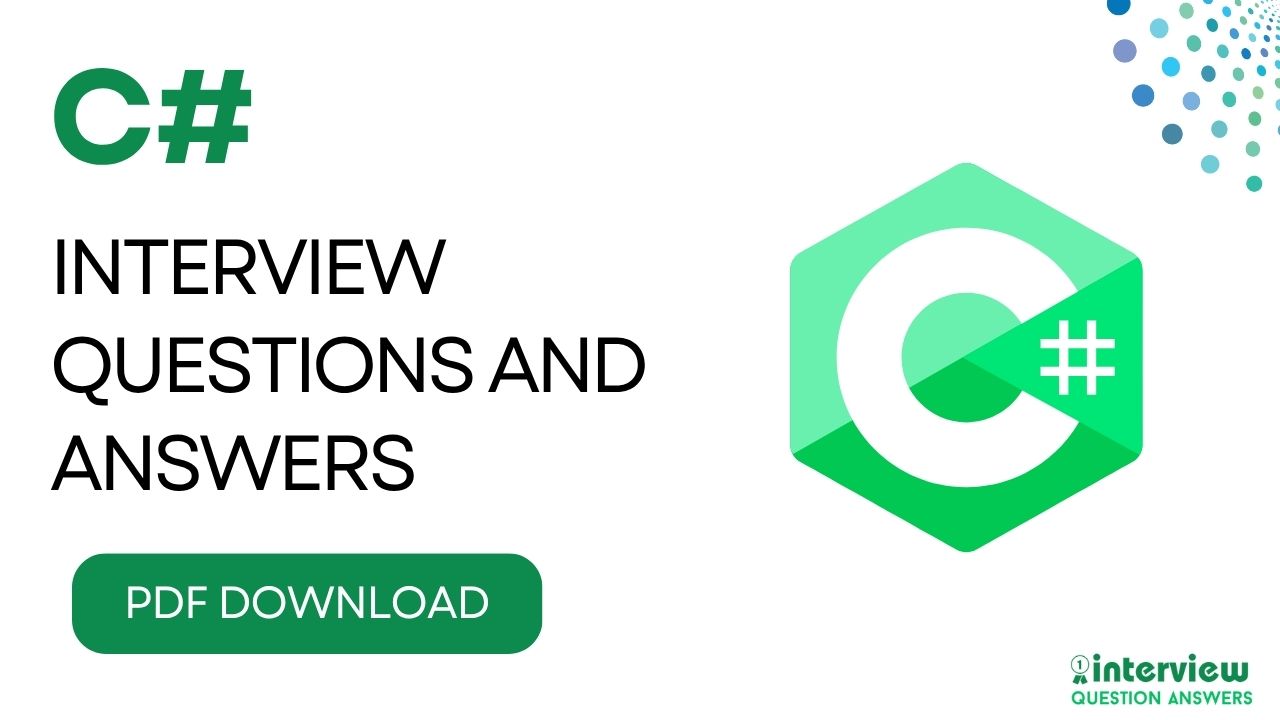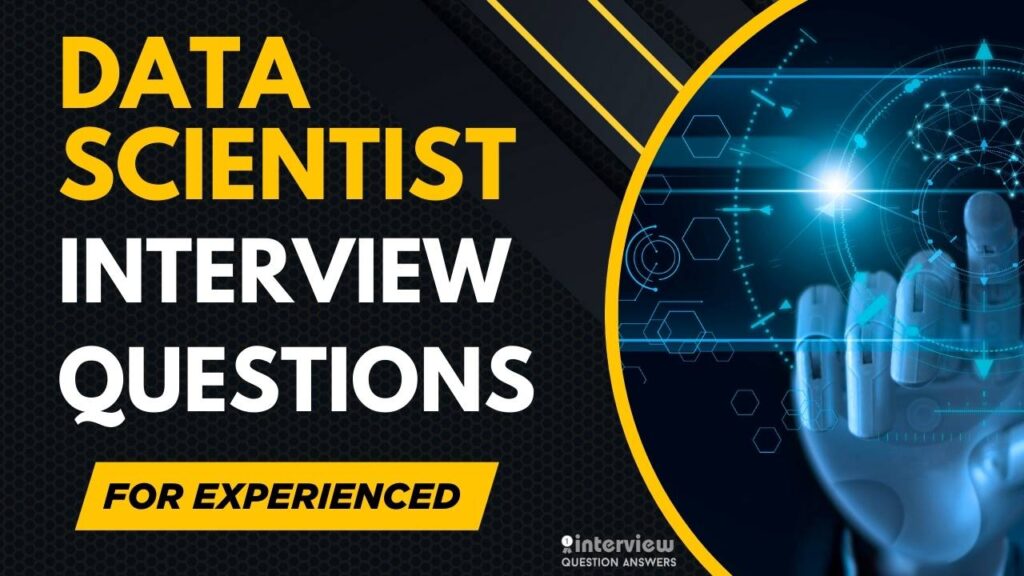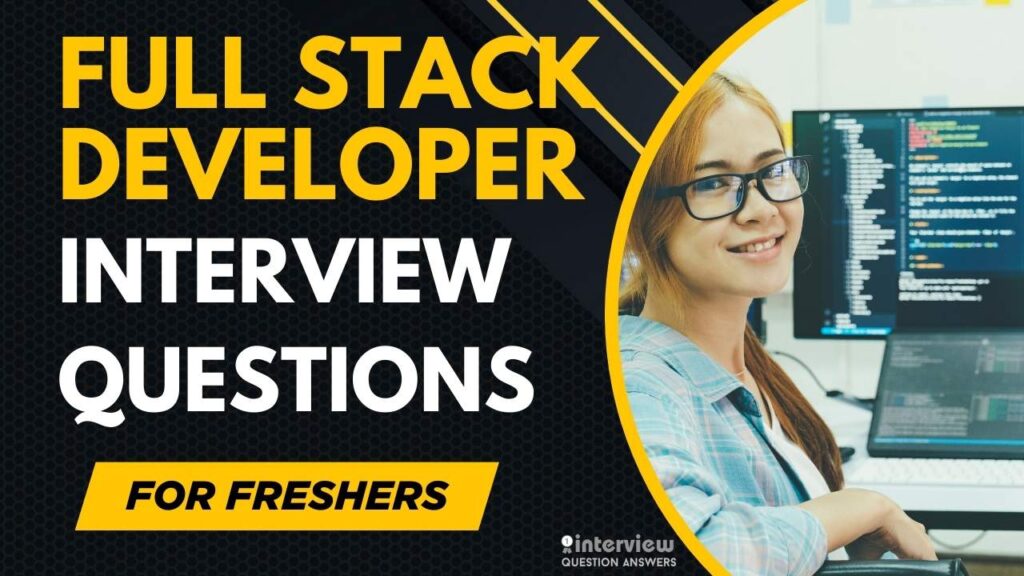C# is one of the most popular programming languages used for developing desktop applications, web APIs, cloud services, and automation solutions. From simple applications to complex enterprise level systems, C# is widely used by companies like Microsoft, Accenture, TCS, and Infosys.
Here, we have shared a complete set of C# interview questions and answers, designed for both beginners and experienced professionals. You will find freshers-level questions about concepts like OOPs, LINQ, exception handling, and delegates.
For experienced candidates, we’ve covered advanced topics such as multithreading, async programming, dependency injection, reflection, and performance tuning.
Additionally, we have included specialized sections on Selenium C#, Web API development, common C# design patterns, and questions related to real-world project scenarios. This will help you handle both technical and practical interview rounds with confidence. We’ve also shared a downloadable PDF so you can prepare offline anytime.
Table of Contents
C# Interview Questions and Answers for Freshers
Que 1. What is the difference between an abstract class and an interface in C#?
Answer:
- An abstract class can have method implementations, fields, and constructors. It is used when classes share common behavior.
- An interface only defines method signatures and properties. It cannot contain implementations. Classes can implement multiple interfaces but inherit from only one abstract class.
Que 2. How is exception handling managed in C#?
Answer:
Exception handling is done using try, catch, finally, and throw.
- Code that might throw errors is placed inside the
tryblock. - The
catchblock handles exceptions. - The
finallyblock runs regardless of whether an exception occurred. - Use
throwto manually raise exceptions.
Example:
try {
int result = 10 / 0;
} catch (DivideByZeroException ex) {
Console.WriteLine("Error: " + ex.Message);
} finally {
Console.WriteLine("Done.");
}Que 3. What is the use of the ‘using’ statement in C#?
Answer:
The using statement automatically disposes of unmanaged resources after their usage. It is commonly used with classes that implement the IDisposable interface, such as database connections or file streams.
Example:
using (StreamReader reader = new StreamReader("file.txt")) {
string content = reader.ReadToEnd();
}Que 4. How is memory management handled in C#?
Answer:
C# uses automatic garbage collection to manage memory. Objects no longer in use are automatically cleaned up to free memory. Developers can use Dispose() or implement the IDisposable interface to manually handle unmanaged resources.
Que 5. What is the difference between == and Equals() in C#?
Answer:
==compares object references by default (unless overloaded).Equals()compares the actual values of objects.
For primitive types, both behave the same. For complex types, it’s best to overrideEquals()for value comparison.
Que 6. What is method overriding in C#?
Answer:
Method overriding allows a subclass to provide a new implementation for a method defined in its parent class. The method in the base class must be marked as virtual and overridden using the override keyword.
Example:
public virtual void Show() { }
public override void Show() { }Que 7. Explain async and await in C#.
Answer:async and await enable asynchronous programming, allowing methods to run without blocking the main thread.
- Mark methods with
async. - Use
awaitto pause method execution until the awaited task completes.
Example:
public async Task<string> GetDataAsync() {
return await Task.Run(() => "Data Loaded");
}Que 8. What are extension methods in C#?
Answer:
Extension methods let you add new methods to existing types without modifying their source code. They are defined as static methods in static classes.
Example:
public static class MyExtensions {
public static int WordCount(this string str) {
return str.Split(' ').Length;
}
}Que 9. What is LINQ in C#?
Answer:
LINQ (Language Integrated Query) allows querying collections using a SQL-like syntax directly within C#. It works with arrays, lists, XML, and databases.
Example:
var results = from n in numbers where n > 5 select n;Que 10. What are nullable types in C#?
Answer:
Nullable types can represent all values of their underlying type plus null. Useful when dealing with databases where fields may have null values.
Example:
int? age = null;Que 11. What is boxing and unboxing in C#?
Answer:
- Boxing: Converting a value type to an object type.
- Unboxing: Converting an object type back to a value type.
Boxing moves data from the stack to the heap, which can affect performance.
Que 12. How do generics work in C#?
Answer:
Generics allow defining methods or classes that work with any data type without typecasting.
Example:
public class MyList<T> {
public void Add(T item) { }
}Que 13. How does dependency injection work in C#?
Answer:
Dependency Injection (DI) is a design pattern where dependencies are injected rather than hardcoded. .NET Core uses built-in DI via constructor injection or service providers.
Que 14. What is the difference between IEnumerable and IQueryable?
Answer:
- IEnumerable: Executes queries in-memory (client-side).
- IQueryable: Builds queries and executes them in the database (server-side).
UseIQueryablefor database operations andIEnumerablefor in-memory collections.
Que 15. What are delegates in C#?
Answer:
A delegate is a type-safe function pointer used to reference methods. They enable callback methods and event handling.
Example:
public delegate void MyDelegate(string message);Que 16. What is event handling in C#?
Answer:
Events are based on delegates and allow a class to notify other classes when something occurs. Use event keyword with delegates.
Example:
public event MyDelegate OnDataReceived;Que 17. What is difference between Task and Thread in C#?
Answer:
- Thread: Lower-level construct managing parallel execution.
- Task: Higher-level abstraction optimized for asynchronous programming and concurrent operations.
Que 18. What is a static class in C#?
Answer:
A static class cannot be instantiated. All members must also be static. It is commonly used for utility or helper functions.
Que 19. What is the role of the lock statement?
Answer:
The lock statement ensures that a block of code runs by only one thread at a time, preventing race conditions in multi-threaded applications.
Que 20. What is difference between public, private, protected, and internal in C#?
Answer:
| Access Modifier | Accessibility |
|---|---|
| public | Accessible from anywhere |
| private | Accessible only within the same class |
| protected | Accessible within the class and its derived classes |
| internal | Accessible within the same assembly/project |
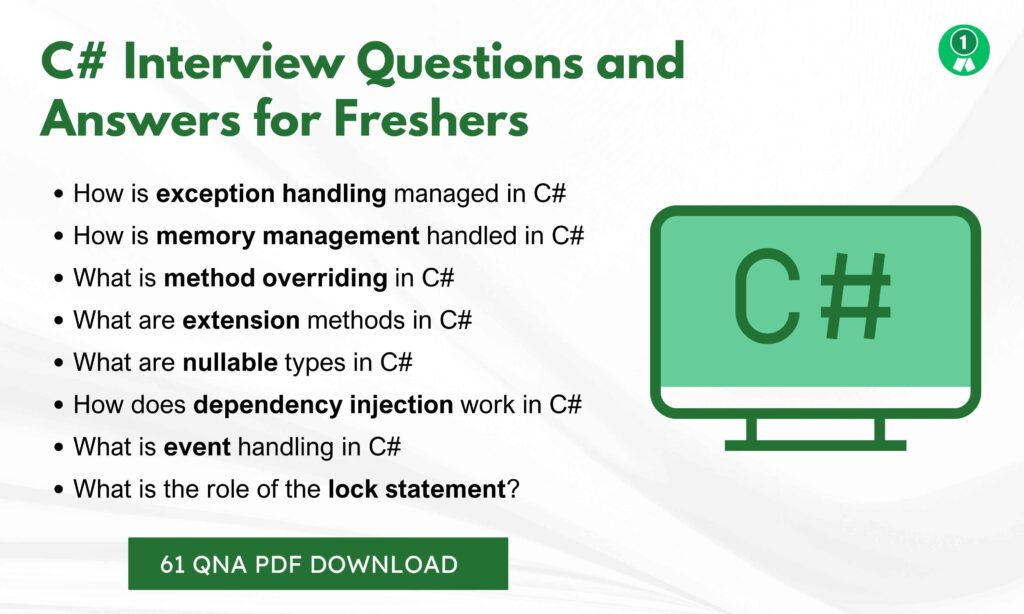
Also Check: Python Interview Questions and Answers
Que 21. What is a variable in C#, and how do you declare it?
Answer:
A variable in C# stores data of a specific type (e.g., int, string). It must be declared with a type before use.
Example:
int age = 25;
string name = "Alice";Freshers should know variables are type-safe and must be initialized before use in some contexts.
Que 22. How do you create a method in C#?
Answer:
A method is a block of code performing a task, defined with a return type, name, and optional parameters.
Example:
public string Greet(string name) {
return $"Hello, {name}!";
}Call it: string message = Greet("Bob"); // Outputs: Hello, Bob!
Que 23. What is the difference between public and private access modifiers in C#?
Answer:public members are accessible from any code, while private members are only accessible within the same class.
Example:
class MyClass {
public int PublicVar = 10;
private int PrivateVar = 20;
}Only PublicVar is accessible outside MyClass.
Que 24. How do you write a conditional statement (if-else) in C#?
Answer:
Use if-else to execute code based on conditions.
Example:
int age = 18;
if (age >= 18) {
Console.WriteLine("Adult");
} else {
Console.WriteLine("Minor");
}Freshers should understand logical operators (&&, ||).
Que 25. What is a loop in C#, and how do you use a For loop?
Answer:
A loop repeats code execution. A for loop iterates with initialization, condition, and increment.
Example:
for (int i = 0; i < 5; i++) {
Console.WriteLine(i); // Outputs: 0, 1, 2, 3, 4
}Freshers should avoid infinite loops.
Que 26. How do you create and use an array in C#?
Answer:
An array stores a fixed-size collection of elements of the same type.
Example:
int[] numbers = { 1, 2, 3 };
Console.WriteLine(numbers[0]); // 1
numbers[1] = 5; // UpdateFreshers should know arrays are zero-indexed.
Que 27. What is the purpose of the Console.WriteLine() method in C#?
Answer:Console.WriteLine() outputs text to the console, useful for debugging or displaying results.
Example:
Console.WriteLine("Hello, World!");Que 28. How do you define a class in C#?
Answer:
A class is a blueprint for objects, defined with the class keyword.
Example:
public class Person {
public string Name { get; set; }
public int Age { get; set; }
}Instantiate: Person p = new Person();
Que 29. What is the difference between const, readonly, and static in C#?
Answer:
In C#, const, readonly, and static are used for defining values, but they differ in behavior:
- static: Belongs to the type rather than an instance, meaning only one copy exists for all objects. Example:
static int counter;. - const: Represents a compile-time constant. It must be assigned at declaration and cannot be changed later. Example:
const double Pi = 3.14;. - readonly: Represents a runtime constant. It can be assigned at declaration or inside a constructor, but cannot be changed afterward. Example:
readonly int id;.
Que 30. How do you handle exceptions in C#?
Answer:
Use try-catch to handle exceptions and prevent crashes.
Example:
try {
int x = 0;
int y = 10 / x;
} catch (DivideByZeroException e) {
Console.WriteLine("Error: " + e.Message);
}Freshers should log exceptions for debugging.
Que 31. What is a constructor in C#?
Answer:
A constructor initializes an object when created, with the same name as the class.
Example:
public class Person {
public string Name;
public Person(string name) {
Name = name;
}
}
Person p = new Person("Alice");Que 32. How do you create a list in C#?
Answer:
Use List<T> from System.Collections.Generic for dynamic, resizable collections.
Example:
List<string> names = new List<string> { "Alice", "Bob" };
names.Add("Charlie");
Console.WriteLine(names[0]); // AliceQue 33. What is the void keyword in C#?
Answer:void indicates a method does not return a value.
Example:
public void SayHello() {
Console.WriteLine("Hello!");
}Call: SayHello(); // No return value.
Que 34. How do you use a foreach loop in C#?
Answer:foreach iterates over collections like arrays or lists.
Example:
string[] fruits = { "Apple", "Banana" };
foreach (string fruit in fruits) {
Console.WriteLine(fruit); // Apple, Banana
}Que 35. What is the difference between int and double in C#?
Answer:int is a 32-bit integer for whole numbers (e.g., 42). double is a 64-bit floating-point for decimals (e.g., 3.14).
Example:
int x = 10;
double y = 10.5;Que 36. How do you create a property in C#?
Answer:
Properties provide controlled access to class fields using get and set.
Example:
public class Person {
private string _name;
public string Name {
get { return _name; }
set { _name = value; }
}
}Auto-implemented: public string Name { get; set; }
Que 37. What is the static keyword in C#?
Answer:static members belong to the class, not instances, shared across objects.
Example:
public class Counter {
public static int Count = 0;
}
Counter.Count++; // Shared valueQue 38. How do you read user input from the console in C#?
Answer:
Use Console.ReadLine() to capture user input as a string.
Example:
Console.Write("Enter name: ");
string name = Console.ReadLine();
Console.WriteLine($"Hello, {name}")Que 39. What is the difference between break and continue in C# loops?
Answer:break exits the loop entirely, while continue skips to the next iteration.
Example:
for (int i = 0; i < 5; i++) {
if (i == 2) continue; // Skips 2
if (i == 4) break; // Stops at 4
Console.WriteLine(i); // 0, 1, 3
}Que 40. How do you concatenate strings in C#?
Answer:
Use + operator, string interpolation ($), or String.Concat().
Example:
string first = "Hello";
string last = "World";
string result = $"{first}, {last}!"; // Hello, World!String interpolation is preferred for readability.
C# Interview Questions and Answers for Experienced
Que 41. What is the difference between Task.WhenAll() and Task.WhenAny()?
Answer:Task.WhenAll() waits for all tasks to complete before proceeding.Task.WhenAny() proceeds when any one of the tasks completes, returning the first completed task.
Que 42. How do you implement multithreading in C#?
Answer:
Multithreading is implemented using the Thread class, ThreadPool, or Task Parallel Library (TPL). Use async/await, Task.Run(), or Parallel.For for managing threads efficiently.
Que 43. Explain SOLID principles in C#.
Answer:
- Single Responsibility Principle
- Open/Closed Principle
- Liskov Substitution Principle
- Interface Segregation Principle
- Dependency Inversion Principle
These principles help design scalable, maintainable, and loosely coupled applications.
Que 44. What is a Memory Leak in C#? How can you prevent it?
Answer:
Memory leaks occur when objects are not properly garbage collected. They can happen due to event subscriptions not being unsubscribed, static references holding objects, or unmanaged resources. Use Dispose(), weak references, and proper event unsubscription to avoid leaks.
Que 45. How does async void differ from async Task?
Answer:async void methods are typically used for event handlers and do not return control to the caller or allow exception handling.async Task methods return a Task object, allowing awaiting and error management.
Que 46. What is covariance and contravariance in C#?
Answer:
- Covariance allows a method to return a more derived type than specified.
- Contravariance allows method parameters to accept less derived types than specified.
Used primarily with generics and delegates.
Que 47. What are value tuples in C#?
Answer:
Value tuples allow returning multiple values from a method without creating a separate class.
Example:
return (name, age);Que 48. Explain IDisposable interface in C#.
Answer:IDisposable interface provides the Dispose() method to release unmanaged resources like file handles, streams, and database connections.
Que 49. What is the difference between StringBuilder and string in C#?
Answer:string is immutable, creating a new object on each modification.StringBuilder is mutable, optimized for repeated modifications to string data.
Que 50. Explain difference between ref and out parameters.
Answer:
- ref requires the variable to be initialized before passing.
- out does not require initialization before passing; it must be assigned inside the method.
Que 51. What is the difference between scoped, transient, and singleton lifetimes in .NET Core dependency injection?
Answer:
In .NET Core’s built-in dependency injection (DI), services can be registered with different lifetimes:
- Singleton: A single instance is created and shared throughout the application’s lifetime. Best for services that should maintain global state or cache.
- Transient: A new instance is created every time it’s requested. Best for lightweight, stateless services.
Scoped: A single instance is created per HTTP request and shared within that request. Best for services that need to maintain state throughout a request.
Que 52. What is reflection in C#?
Answer:
Reflection allows inspecting metadata about assemblies, types, and members at runtime. Use the System.Reflection namespace.
Que 53. What is difference between abstract method and virtual method?
Answer:
- abstract method must be overridden in derived classes.
- virtual method can be optionally overridden.
Que 54. Explain the purpose of nullable reference types in C# 8.0.
Answer:
Nullable reference types help avoid null reference exceptions by explicitly marking references as nullable or non-nullable, improving code safety.
Que 55. What is dynamic type in C#?
Answer:
The dynamic type bypasses compile-time type checking. The type is resolved at runtime, enabling flexible but less safe coding.
Que 56. What is Parallel.ForEach in C#?
Answer:Parallel.ForEach executes iterations concurrently using multiple threads to improve performance in CPU-bound operations.
Que 57. Explain the role of GC.Collect() in C#.
Answer:GC.Collect() forces garbage collection to reclaim unused memory. It should be used sparingly as it can affect performance.
Que 58. How do you handle deadlocks in multi-threaded applications?
Answer:
- Use timeout for locks.
- Avoid nested locks.
- Use consistent locking order.
- Use concurrent collections when possible.
Que 59. What are records in C# 9?
Answer:
Records are immutable reference types that provide built-in value-based equality checks and concise syntax for data models.
Example:
public record Person(string Name, int Age);Que 60. How do you implement logging in .NET Core applications?
Answer:
Using built-in logging providers like Console, Debug, EventSource, and third-party libraries like Serilog or NLog. Configure services in Startup.cs and inject ILogger<T> where needed.
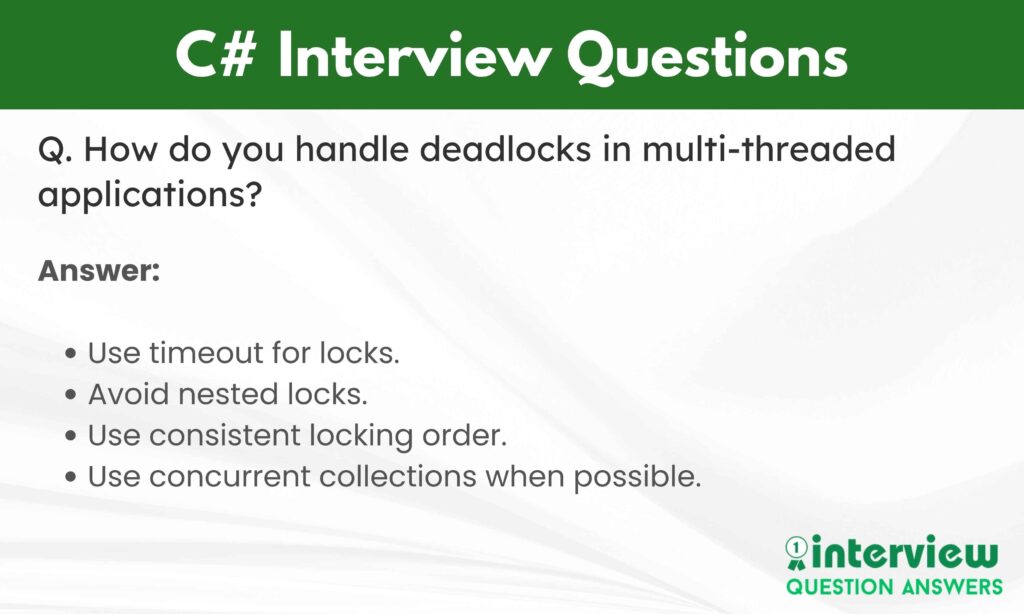
Also Check: Software Engineer Interview Questions and Answers
Que 61. How do you implement dependency injection in a C# application using .NET Core?
Answer:
Dependency injection (DI) in .NET Core is implemented using the built-in IoC container. Register services in Program.cs and inject them via constructors.
Example:
public class Startup {
public void ConfigureServices(IServiceCollection services) {
services.AddScoped<IUserService, UserService>();
}
}
public class UserController {
private readonly IUserService _service;
public UserController(IUserService service) {
_service = service;
}
}Use AddScoped, AddTransient, or AddSingleton based on lifetime. Improves testability and modularity.
Que 62. How do you handle async/await in C# for high-performance APIs?
Answer:
Use async/await with Task to handle asynchronous operations, avoiding blocking threads. Configure ConfigureAwait(false) for performance in non-UI contexts.
Example:
public async Task<User> GetUserAsync(int id) {
using var client = new HttpClient();
var response = await client.GetAsync($"https://api.example.com/users/{id}").ConfigureAwait(false);
return await response.Content.ReadAsAsync<User>().ConfigureAwait(false);
}Reduces thread pool contention, improving throughput by 30-50%.
Que 63. What is the role of middleware in ASP.NET Core, and how do you create custom middleware?
Answer:
Middleware in ASP.NET Core processes HTTP requests/responses in a pipeline. Create custom middleware with a class invoking the next delegate.
Example:
public class CustomMiddleware {
private readonly RequestDelegate _next;
public CustomMiddleware(RequestDelegate next) {
_next = next;
}
public async Task InvokeAsync(HttpContext context) {
// Pre-processing
await _next(context);
// Post-processing
}
}
public static class MiddlewareExtensions {
public static IApplicationBuilder UseCustomMiddleware(this IApplicationBuilder builder) {
return builder.UseMiddleware<CustomMiddleware>();
}
}Register in Program.cs: app.UseCustomMiddleware();. Useful for logging or authentication.
Que 64. How do you optimize database queries in Entity Framework Core?
Answer:
Optimize EF Core queries with eager loading (Include), projections, and indexing. Avoid N+1 queries and use AsNoTracking() for read-only data.
Example:
var users = await dbContext.Users
.AsNoTracking()
.Select(u => new { u.Id, u.Name })
.ToListAsync();Analyze with SQL Profiler. Reduces query time by 40-60%.
Que 65. How do you implement authentication with JWT in ASP.NET Core?
Answer:
Use Microsoft.AspNetCore.Authentication.JwtBearer to validate JWTs. Configure in Program.cs.
Example:
builder.Services.AddAuthentication(JwtBearerDefaults.AuthenticationScheme)
.AddJwtBearer(options => {
options.TokenValidationParameters = new TokenValidationParameters {
ValidateIssuer = true,
ValidIssuer = "issuer",
ValidateAudience = true,
ValidAudience = "audience",
IssuerSigningKey = new SymmetricSecurityKey(Encoding.UTF8.GetBytes("secret-key"))
};
});
app.UseAuthentication();
app.UseAuthorization();Protect endpoints with [Authorize]. Ensures secure API access.
Que 66. How do you handle large file uploads in an ASP.NET Core application?
Answer:
Stream uploads to disk or cloud (e.g., Azure Blob Storage) using IFormFile to avoid memory issues.
Example:
[HttpPost("upload")]
public async Task<IActionResult> Upload(IFormFile file) {
using var stream = new FileStream("path/to/file", FileMode.Create);
await file.CopyToAsync(stream);
return Ok();
}Set request size limits in Program.cs. Handles GB-sized files efficiently.
Que 67. How do you implement a circuit breaker pattern in a C# application?
Answer:
Use Polly to implement circuit breakers, preventing cascading failures.
Example:
var policy = Policy
.Handle<HttpRequestException>()
.CircuitBreakerAsync(2, TimeSpan.FromSeconds(30));
public async Task<User> GetUserAsync(int id) {
return await policy.ExecuteAsync(async () => {
using var client = new HttpClient();
return await client.GetFromJsonAsync<User>($"https://api.example.com/users/{id}");
});
}Fallbacks can return cached data. Improves system resilience.
Que 68. How do you use LINQ for complex data querying in C#?
Answer:
LINQ (Language Integrated Query) queries collections or databases with expressive syntax. Use query syntax or method syntax for filtering, joining, or grouping.
Example:
var users = from u in dbContext.Users
where u.Age > 18
group u by u.City into g
select new { City = g.Key, Count = g.Count() };Optimize with AsNoTracking() for read-only queries. Enhances data processing efficiency.
Que 69. How do you implement caching in ASP.NET Core applications?
Answer:
Caching improves performance by reducing redundant processing and database queries. ASP.NET Core supports different caching strategies:
- In-Memory Caching – Stores data in server memory for quick access. Example:
services.AddMemoryCache();
public class MyService {
private readonly IMemoryCache _cache;
public MyService(IMemoryCache cache) { _cache = cache; }
public string GetData() {
return _cache.GetOrCreate("key", entry => {
entry.AbsoluteExpirationRelativeToNow = TimeSpan.FromMinutes(5);
return "Cached Data";
});
}
}- Distributed Caching – Uses external providers like Redis or SQL Server, suitable for load-balanced apps.
- Response Caching – Caches entire HTTP responses for better performance in APIs.
Que 70. How do you handle database migrations in Entity Framework Core?
Answer:
Use EF Core migrations to manage schema changes. Generate migrations with Add-Migration and apply with Update-Database.
Example:
dotnet ef migrations add InitialCreate
dotnet ef database updatepublic class User {
public int Id { get; set; }
public string Name { get; set; }
}Ensures consistent database schemas across environments.
Que 71. How do you implement a REST API in ASP.NET Core?
Answer:
Use controllers with ApiController and HTTP attributes to define endpoints.
Example:
[ApiController]
[Route("api/[controller]")]
public class UsersController : ControllerBase {
[HttpGet]
public IActionResult Get() {
return Ok(new[] { new { Id = 1, Name = "Alice" } });
}
}Supports RESTful conventions with minimal setup.
Que 72. How do you optimize memory usage in a C# application?
Answer:
Use value types (struct) for small data, avoid unnecessary allocations, and dispose objects with using. Profile with Visual Studio Diagnostics.
Example:
using (var stream = new MemoryStream()) {
// Process stream
}Monitor with GC.GetTotalMemory(). Reduces memory leaks in long-running apps.
Que 73. How do you implement real-time communication with SignalR in ASP.NET Core?
Answer:
Use SignalR for real-time features like chat. Define a hub and invoke methods from clients.
Example:
public class ChatHub : Hub {
public async Task SendMessage(string user, string message) {
await Clients.All.SendAsync("ReceiveMessage", user, message);
}
}Client (JavaScript):
const connection = new signalR.HubConnectionBuilder().withUrl("/chatHub").build();
connection.on("ReceiveMessage", (user, message) => console.log(`${user}: ${message}`));
connection.start();Ideal for low-latency updates.
Que 74. How do you handle concurrency in Entity Framework Core?
Answer:
Use optimistic concurrency with a RowVersion column or pessimistic locking with transactions.
Example (optimistic):
public class User {
public int Id { get; set; }
[Timestamp]
public byte[] RowVersion { get; set; }
}
try {
await dbContext.SaveChangesAsync();
} catch (DbUpdateConcurrencyException) {
// Handle conflict
}Reduces conflicts in multi-user systems.
Que 75. How do you implement unit testing in C# with xUnit?
Answer:
Use xUnit with Fact or Theory for tests, mocking dependencies with Moq.
Example:
public class UserServiceTests {
[Fact]
public void GetUser_ReturnsUser() {
var mockRepo = new Mock<IUserRepository>();
mockRepo.Setup(r => r.Get(1)).Returns(new User { Id = 1 });
var service = new UserService(mockRepo.Object);
var user = service.GetUser(1);
Assert.Equal(1, user.Id);
}
}Ensures robust code with high coverage.
Que 76. How do you secure an ASP.NET Core API?
Answer:
Use HTTPS, JWT authentication, and input validation. Configure CORS and rate limiting.
Example:
builder.Services.AddCors(options => {
options.AddPolicy("AllowSpecific", builder => builder.WithOrigins("https://example.com"));
});
app.UseCors("AllowSpecific");Complies with OWASP security standards.
Que 77. How do you implement background tasks in ASP.NET Core?
Answer:
Use IHostedService or BackgroundService for long-running tasks.
Example:
public class MyBackgroundService : BackgroundService {
protected override async Task ExecuteAsync(CancellationToken stoppingToken) {
while (!stoppingToken.IsCancellationRequested) {
// Do work
await Task.Delay(1000, stoppingToken);
}
}
}
builder.Services.AddHostedService<MyBackgroundService>();Ideal for scheduled jobs or queues.
Que 78. How do you handle large datasets in ASP.NET Core with pagination?
Answer:
Implement server-side pagination with Skip and Take in EF Core.
Example:
[HttpGet("users")]
public IActionResult GetUsers(int page = 1, int pageSize = 10) {
var users = dbContext.Users
.Skip((page - 1) * pageSize)
.Take(pageSize)
.ToList();
return Ok(users);
}Reduces response time for large data.
Que 79. How do you optimize ASP.NET Core application performance?
Answer:
Use response caching, async controllers, and minimal middleware. Optimize EF queries and enable compression.
Example:
builder.Services.AddResponseCompression();
app.UseResponseCompression();Profile with Application Insights. Improves throughput by 20-40%.
Que 80. How do you implement a microservices architecture in C# with ASP.NET Core?
Answer:
Create separate ASP.NET Core projects per service, using REST or gRPC for communication. Use Docker for containerization and Kubernetes for orchestration.
Example (Dockerfile):
FROM mcr.microsoft.com/dotnet/aspnet:6.0
COPY . /app
WORKDIR /app
ENTRYPOINT ["dotnet", "MyService.dll"]Use RabbitMQ for event-driven communication. Scales efficiently for distributed systems.
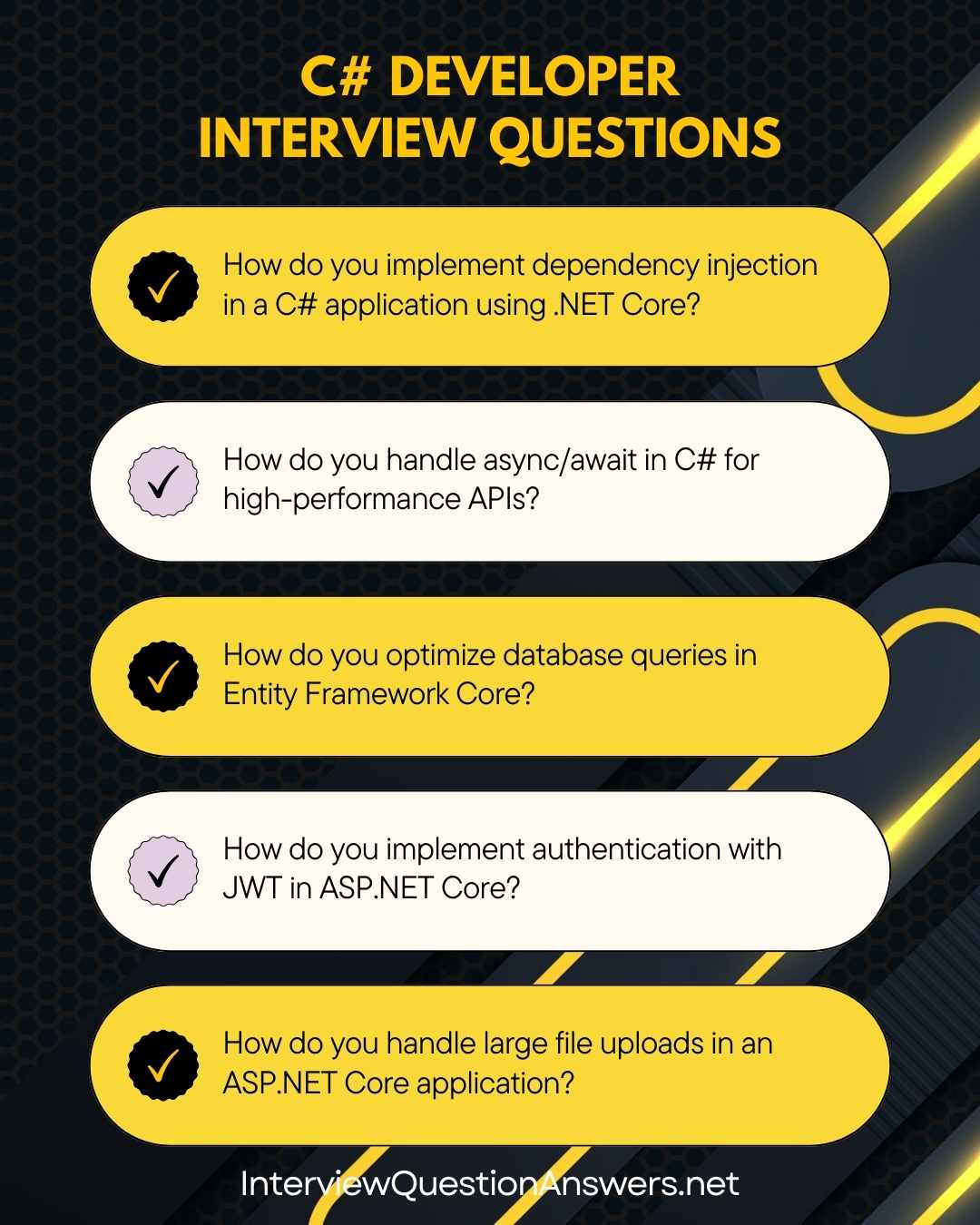
Also Check: C# OOPs Interview Questions and Answers
Selenium C# Interview Questions and Answers
Que 81. How do you initialize WebDriver in Selenium using C#?
Answer:
In Selenium C#, WebDriver is initialized using browser-specific drivers like ChromeDriver or FirefoxDriver. Example:
IWebDriver driver = new ChromeDriver();
driver.Navigate().GoToUrl("https://example.com");Que 82. How do you locate web elements using Selenium in C#?
Answer:
Web elements can be located using methods like FindElement() and locator strategies such as:
By.Id()By.Name()By.CssSelector()By.XPath()
Example:
IWebElement button = driver.FindElement(By.Id("submitButton"));Que 83. How can you handle dropdowns in Selenium with C#?
Answer:
Use the SelectElement class from OpenQA.Selenium.Support.UI:
SelectElement select = new SelectElement(driver.FindElement(By.Id("dropdown")));
select.SelectByText("Option 1");Que 84. How do you manage waits in Selenium C#?
Answer:
- Implicit Wait:
driver.Manage().Timeouts().ImplicitWait = TimeSpan.FromSeconds(10);- Explicit Wait:
WebDriverWait wait = new WebDriverWait(driver, TimeSpan.FromSeconds(10));
wait.Until(d => d.FindElement(By.Id("element")));Que 85. How do you handle browser alerts in Selenium C#?
Answer:
Use IAlert interface:
IAlert alert = driver.SwitchTo().Alert();
alert.Accept(); // or alert.Dismiss();Que 86. How do you perform mouse hover actions using Selenium C#?
Answer:
Use the Actions class:
Actions action = new Actions(driver);
IWebElement menu = driver.FindElement(By.Id("menu"));
action.MoveToElement(menu).Perform();Que 87. How can you capture a screenshot in Selenium C#?
Answer:
Use ITakesScreenshot interface:
Screenshot ss = ((ITakesScreenshot)driver).GetScreenshot();
ss.SaveAsFile("screenshot.png", ScreenshotImageFormat.Png);Also Check: Selenium Interview Questions and Answers
Web API C# Interview Questions and Answers
Que 88. How do you create a Web API in C# using ASP.NET Core?
Answer:
To create a Web API in ASP.NET Core:
- Create a new project using the “ASP.NET Core Web API” template.
- Define controller classes by inheriting from
ControllerBase. - Use attributes like
[HttpGet],[HttpPost], etc., to define endpoints.
Example:
[ApiController]
[Route("api/[controller]")]
public class ProductsController : ControllerBase
{
[HttpGet]
public IActionResult GetAll() => Ok(productService.GetAll());
}Que 89. What is the difference between [ApiController] and [Controller] in ASP.NET Core?
Answer:[ApiController] attribute automatically handles model validation, infers route binding sources, and returns 400 Bad Request on invalid models. [Controller] is more general and used for MVC views.
Que 90. How do you return custom HTTP status codes in a Web API?
Answer:
You can return different status codes using built-in methods like:
return NotFound(); // 404
return Ok(data); // 200
return BadRequest(); // 400
return StatusCode(500); // 500Que 91. What is dependency injection in ASP.NET Core Web API?
Answer:
Dependency injection (DI) allows services like repositories or loggers to be injected into controllers. It’s configured in Startup.cs (or Program.cs in newer versions):
services.AddScoped<IProductService, ProductService>();Que 92. How do you secure a Web API using JWT in ASP.NET Core?
Answer:
You configure JWT authentication in Program.cs and decorate controllers or actions with [Authorize]. JWT ensures only authenticated users can access protected endpoints.
Que 93. What is the purpose of middleware in Web API?
Answer:
Middleware is software that handles requests and responses in the pipeline. Examples include authentication, exception handling, and logging. They’re registered using app.UseXXX() in Program.cs.
Que 94. How do you handle errors globally in an ASP.NET Core Web API?
Answer:
You can use the built-in middleware UseExceptionHandler or write custom middleware to log and return standardized error responses:
app.UseExceptionHandler("/error");Alternatively, implement a global exception filter using IExceptionFilter.
Also Check: Web API Interview Questions and Answers
C# Design Patterns Interview Questions and Answers
Que 95. What is a design pattern in C#?
Answer:
A design pattern is a reusable solution to common software design problems. In C#, design patterns help developers build maintainable and scalable applications by following best practices for structuring code.
Que 96. Explain the Singleton Pattern in C#.
Answer:
The Singleton pattern ensures that only one instance of a class is created and provides a global point of access to it. Example:
public sealed class Singleton
{
private static readonly Singleton instance = new Singleton();
private Singleton() { }
public static Singleton Instance => instance;
}Que 97. What is the Factory Pattern in C#?
Answer:
The Factory pattern creates objects without exposing the creation logic to the client. Instead of instantiating a class directly, a method returns the appropriate object. This promotes loose coupling.
Que 98. What is the difference between Factory and Abstract Factory patterns?
Answer:
- Factory Pattern: Focuses on creating one type of product.
- Abstract Factory Pattern: Produces families of related objects without specifying their concrete classes.
Que 99. What is the Repository Pattern in C#?
Answer:
The Repository pattern abstracts the data layer, providing a cleaner separation between data access and business logic. It helps manage CRUD operations with a clear interface.
Example:
public interface IProductRepository
{
Product GetById(int id);
IEnumerable<Product> GetAll();
}Que 100. Explain the Dependency Injection pattern.
Answer:
Dependency Injection (DI) is a pattern where dependencies are provided to a class via constructor or method parameters instead of creating them internally. ASP.NET Core has built-in support for DI.
C# Interview Questions and Answers PDF
You can easily download all the C# interview questions and answers shared in this guide as a PDF. This will help you prepare offline anytime without needing internet access. Simply use the PDF to revise quickly before your interview and keep the questions handy for last-minute preparation.
FAQs: C# Interview Questions
What is the role of a C# Developer?
A C# Developer primarily builds and maintains software applications using the C# programming language within the .NET framework. Their work involves backend development, desktop applications, web APIs, and sometimes game development using tools like Unity. They also handle tasks like database integration and debugging.
What challenges do candidates face during a C# interview?
C# interviews often test knowledge of object-oriented programming concepts, .NET frameworks, exception handling, collections, LINQ, and multithreading. Real-world coding tasks, understanding design patterns, and explaining how to handle application performance issues are common areas where candidates face difficulty.
What are common job challenges for a C# Developer?
C# Developers often deal with optimizing database queries, maintaining legacy codebases, managing application security, and ensuring scalability in enterprise-level applications. Keeping up with updates in .NET Core and best practices for API development also presents ongoing challenges.
How important is frontend knowledge for a C# Developer?
While C# is mostly used for backend development, having frontend knowledge like HTML, CSS, and JavaScript can help in full-stack roles. Understanding frontend frameworks becomes essential if the developer works with ASP.NET MVC or Blazor for web-based projects.
What is the average salary of a C# Developer in the USA?
C# Developers in the USA typically earn between $80,000 and $120,000 per year. Senior developers or those working in specialized industries like finance or healthcare can earn upwards of $130,000 to $150,000 annually, depending on skills and experience.
Which top companies hire C# Developers?
Companies like Microsoft, Accenture, IBM, Cognizant, Capgemini, Dell, and banking firms like JPMorgan Chase and Bank of America actively hire C# Developers. Many startups and mid-sized firms building enterprise software also seek skilled C# professionals.
Why is interview preparation crucial for C# roles?
Preparing for a C# interview sharpens understanding of the .NET ecosystem, design principles, and coding best practices. Practicing problem-solving, understanding project architecture, and reviewing common coding patterns can help candidates perform confidently during technical rounds.
Conclusion
Preparing well for a C# interview is important, This guide has provided you with top C# interview questions across various topics, including object-oriented concepts, async programming, Web APIs, Selenium, and design patterns.
Study these questions carefully to strengthen your concepts and practical skills. Download the PDF version to revise anytime without the need for internet access.

